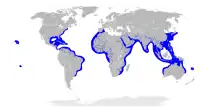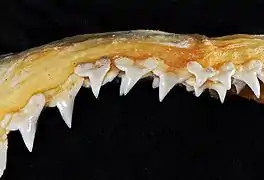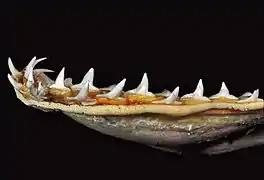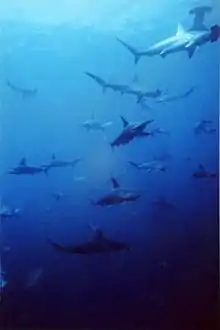Scalloped hammerhead
The scalloped hammerhead (Sphyrna lewini) is a species of hammerhead shark, and part of the family Sphyrnidae. Originally known as Zygaena lewini, its genus name was later changed to its current name. The Greek word sphyrna translates into "hammer" in English, referring to the shape of this shark's head. The most distinguishing characteristic of this shark, as in all hammerheads, is the 'hammer' on its head. The shark's eyes and nostrils are at the tips of the extensions. It is a fairly large hammerhead, but is still smaller than both the great and smooth hammerheads.
| Scalloped hammerhead | |
|---|---|
.jpeg.webp) | |
 | |
| Scientific classification | |
| Kingdom: | Animalia |
| Phylum: | Chordata |
| Class: | Chondrichthyes |
| Order: | Carcharhiniformes |
| Family: | Sphyrnidae |
| Genus: | Sphyrna |
| Species: | S. lewini |
| Binomial name | |
| Sphyrna lewini (E. Griffith & C. H. Smith, 1834) | |
 | |
| Range of the scalloped hammerhead | |
| Synonyms | |
|
Sphyrna couardi Cadenat, 1951 | |
This shark is also known as the bronze, kinky-headed, or southern hammerhead. It primarily lives in warm, temperate, and tropical coastal waters all around the globe between latitudes 46°N and 36°S, down to a depth of 500 m (1,600 ft). It is the most common of all hammerheads.
Taxonomy
The scalloped hammerhead was first named Zygaena lewini and then renamed Sphyrna lewini by Edward Griffith and Hamilton Smith in 1834. It has also been named Cestracion leeuwenii by Day in 1865, Zygaena erythraea by Klunzinger in 1871, Cestracion oceanica by Garman in 1913, and Sphyrna diplana by Springer in 1941. Sphyrna comes from the Greek and translates into hammer.[2]
It is a sister species to Sphyrna gilberti, differing by the number of vertebrae.[3] Though once considered a distinct species, McEachran and Serret synonymized Sphyrna couardi with Sphyrna lewini in 1986.[4]
Description
On average, males measure 1.5 to 1.8 m (4.9 to 5.9 ft) and weigh about 29 kg (64 lb) when they attain sexual maturity, whereas the larger females measure 2.5 m (8.2 ft) and weigh 80 kg (180 lb) on average at sexual maturity.[5] The maximum length of the scalloped hammerhead is 4.3 m (14 ft) and the maximum weight 152.4 kg (336 lb), per FishBase.[6] A female caught off of Miami was found to have measured 3.26 m (10.7 ft) and reportedly weighed 200 kg (440 lb), though was in a gravid state at that point.[7]
These sharks have a very high metabolic rate, governing behavior in acquiring food. These sharks occupy tertiary trophic levels.[8] The scalloped hammerhead shark, like many other species, uses the shore as a breeding ground.[8] Due to high metabolic rates, young scalloped hammerhead sharks need a lot of food, or they will starve.
 Upper teeth
Upper teeth Lower teeth
Lower teeth Juvenile
Juvenile Juvenile
Juvenile
Distribution and habitat
The scalloped hammerhead is a coastal pelagic species; it occurs over continental and insular shelves and in nearby deeper water. It is found in warm temperate and tropical waters, worldwide from 46°N to 36°S. It can be found down to depths over 500 m (1,600 ft), but is most often found above 25 m (82 ft).[9] During the day, they are more often found close to shore, and at night, they hunt further offshore. Adults are found alone, in pairs, or in small schools, while young sharks occur in larger schools.[2]
Juveniles and pups thrive in shallow coastal waters, such as bays and mangroves, which provide shelter from predators and waters high in nutrients from deposited sediments. Research carried out by the non-government organisation Misión Tiburón, using conventional and acoustic shark tagging methods, found that adult scalloped hammerheads migrate from the pelagic waters surrounding Cocos Island to the mangroves in the tropical fjord of Golfo Dulce - a tropical fjord on the pacific coast of Costa Rica.[10] Here, female sharks give birth to live young: juveniles remain in the shallow root system of the mangroves for around three years. After this time they leave Golfo Dulce and migrate back to Cocos Island, to feed in pelagic waters.
Behavior
Schooling

These sharks are often seen during the night, day, and morning in big schools, sometimes numbering hundreds, most likely because large groups can obtain food easier than singles or small groups, especially larger and trickier prey, as commonly seen. The younger the sharks, the closer to the surface they tend to be, while the adults are found much deeper in the ocean. They are not considered dangerous and are normally not aggressive towards humans.
Sexual dimorphism
The female scalloped hammerheads undergo migration offshore at a smaller size than males[11] because the larger classes of the hammerhead, such as those from 100 to 140 cm long, travel deeper down.[11] Males and females differ in that males are observed to stay deeper than female sharks in general.
Sexual maturity generally occurs once the scalloped hammerhead attains 240 cm in total or longer. Physically, the mature females have considerably wider uteri than their maturing counterparts. A lack of mating scars has been found on mature females.[12] Unlike females, males reach sexual maturity at a much smaller size.
The male-to-female ratio of the scalloped hammerhead is 1:1.29.[12] Females probably are capable of giving birth annually.[12] usually in the summer.
Navigating behavior
Scalloped hammerhead sharks have a homing behavior to navigate in the ocean.[13] They move in the night and use the environment as a map, similar to a human reading a topographical map.[13] By experimentation in tagging these sharks, one could test for any guidance in a shark's movement.[13] These sharks use a point-to-point type of school swimming, and do not favor going too deep, where temperature changes hitchhike with current speed and directional change.

The scalloped hammerhead uses deep water to survive as safety and feeding.[14] Although they have high metabolic rates, they have a tendency to be sedentary and allow currents to carry them as they swim. As a result, this causes the scalloped hammerhead to be selective where they swim and the depth at which they tend to stay. They also make use of earths magnetic field.[15]
Predation
The scalloped hammerhead has a lot of advantages to capture its prey. The shape of its head allows it to bury into the seafloor and pin stingrays down. The wide head and special sensory cells allows the scalloped hammerhead to successfully detect fishes.[16]
They are not considered to be dangerous to humans, and if they do harm a human it is because they live in estuaries and attack out of surprise.[15]
Reproduction
The gestation period is reported to be around 12 months.[17] Compared to other species, the scalloped hammerhead produces large litters,[17] and this is most likely due to high infant mortality. Like most sharks, parental care is not seen.[18] Nursery grounds for this species are predictable and repeated over the years, and they are faithful to their natal sites.[18] Their natal sites still cause high infant mortality; a lack of resources prevents all the young from surviving. As a result, only the fittest grow to maturity. Also, should a population get depleted, it recovers through reproduction and not immigration.[18] This species does not seem to attack each other even in periods of starvation. In addition, scalloped hammerheads have migratory behaviors. As a result, deprivation results from migration and young growth. While the Taiwan scalloped hammerhead seems to have an earlier maturity rate, it is still reported to be slow to mature.[19]
Diet
This shark feeds primarily on fish such as sardines, mackerel, and herring, and occasionally they feed on cephalopods such as squid and octopus. Larger specimens may also feed on smaller species of shark such as the blacktip reef shark, Carcharhinus melanopterus.
Conservation
As of 2008, the scalloped hammerhead has been on the "globally endangered" species list. In parts of the Atlantic Ocean, their populations had declined by over 95% in the past 30 years. Among the reasons for this drop are overfishing and the rise in demand for shark fins. Researchers attribute this growth in demand to the increase in shark fins as an expensive delicacy (such as in shark fin soup) and in 2008 called for a ban on shark finning, a practice in which the shark's fins are cut off and the rest of the animal is thrown back in the water to die. Hammerheads are among the most commonly caught sharks for finning.[20] "This species tendency to aggregate in large groups making capture in large numbers on long lines, bottom nets and trawls even easier."[21]
Hammerhead sharks are overfished all around the world for their fins and liver oil. As of 2020 an estimated 1.3 to 2.7 million fins are collected each year from smooth and scalloped hammerhead sharks for the shark-fin trade.[22]
According to a January 2021 study in Nature which studied 31 species of sharks and rays, the number of these species found in open oceans had dropped by 71 per cent in around 50 years. The scalloped hammerhead was included in the study.[23][24]
See also
References
- Rigby, C.L., Dulvy, N.K., Barreto, R., Carlson, J., Fernando, D., Fordham, S., Francis, M.P., Herman, K., Jabado, R.W., Liu, K.M., Marshall, A., Pacoureau, N., Romanov, E., Sherley, R.B. & Winker, H. (2019). "Sphyrna lewini". The IUCN Red List of Threatened Species. IUCN. 2019: e.T39385A2918526.CS1 maint: multiple names: authors list (link)
- "Scalloped Hammerhead". Florida Museum of Natural History.
- Quattro, J. M.; Driggers, W. B. I. I.; Grady, J. M.; Ulrich, G. F.; Roberts, M. A. (2013). "Sphyrna gilberti sp. Nov., a new hammerhead shark (Carcharhiniformes, Sphyrnidae) from the western Atlantic Ocean". Zootaxa. 3702 (2): 159–78. doi:10.11646/zootaxa.3702.2.5. PMID 26146715.
- Martin, R. Aidan. (February 24, 1998). Recent Changes in Hammerhead Taxonomy. ReefQuest Centre for Shark Research. Retrieved on October 18, 2008.
- FLMNH Ichthyology Department: Scalloped Hammerhead. Flmnh.ufl.edu. Retrieved on 2013-05-23.
- Sphyrna lewini, Scalloped hammerhead : fisheries, gamefish. Fishbase.org (2012-07-03). Retrieved on 2013-05-23.
- Castro, José I. (2011) The Sharks of North America. Oxford University Press. ISBN 978-0-19-539294-4
- Duncan, Kanesa May (1 August 2006). "Estimation of daily energetic requirements in young scalloped hammerhead sharks, Sphyrna lewini". Environmental Biology of Fishes. 76 (2–4): 139–149. doi:10.1007/s10641-006-9016-5. S2CID 10155904.
- Froese, Ranier; Pauly, Daniel (eds.). Sphyrna lewini. FishBase. Retrieved 10 December 2008.
- http://misiontiburon.org/en/hammerhead-shark/
- Klimley, A. Pete (1 January 1987). "The determinants of sexual segregation in the scalloped hammerhead shark, Sphyrna lewini". Environmental Biology of Fishes. 18: 27–40. doi:10.1007/BF00002325. S2CID 29448517.
- Hazin, Fabio; Fischer, Alessandra; Broadhurst, Matt (1 June 2001). "Aspects of Reproductive Biology of the Scalloped Hammerhead Shark, Sphyrna lewini, off Northeastern Brazil". Environmental Biology of Fishes. 61 (2): 151–159. doi:10.1023/A:1011040716421. S2CID 44367667.
- Klimley, A. P. (1993). "Highly directional swimming by scalloped hammerhead sharks, Sphyrna lewini, and subsurface irradiance, temperature, bathymetry, and geomagnetic field". Marine Biology. 117: 1–22. doi:10.1007/BF00346421. S2CID 86223091.
- Jorgensen, S. J.; Klimley, A. P.; Muhlia-Melo, A. F. (2009). "Scalloped hammerhead shark Sphyrna lewini, uses deep-water, hypoxic zone in the Gulf of California". Journal of Fish Biology. 74 (7): 1682–1687. doi:10.1111/j.1095-8649.2009.02230.x. PMID 20735666.
- "Fact Sheet: Scalloped Hammerhead Shark". www.sharkinfo.ch. Retrieved 30 March 2020.
- "Smooth Hammerhead Shark". Oceana. Retrieved 18 February 2020.
- Branstetter, Steven (1 July 1987). "Age, growth and reproductive biology of the silky shark, Carcharhinus falciformis, and the scalloped hammerhead, Sphyrna lewini, from the northwestern Gulf of Mexico". Environmental Biology of Fishes. 19 (3): 161–173. doi:10.1007/BF00005346. S2CID 41048341.
- Duncan, K. M.; Martin, A. P.; Bowen, B. W.; De Couet, H. G. (2006). "Global phylogeography of the scalloped hammerhead shark (Sphyrna lewini)". Molecular Ecology. 15 (8): 2239–2251. doi:10.1111/j.1365-294X.2006.02933.x. PMID 16780437. S2CID 25219770.
- Chen, CT; Leu, TC; Joung, SJ; Lo, NCH (1990). "Age and growth of the scalloped hammerhead, Sphyrna lewini, in northeastern Taiwan waters". Pacific Science. 44 (2): 156–170.
- Savage, Sam (19 February 2008). "Hammerhead Shark Makes Endangered Species List". redorbit.com.
- "Sphyrna lewini". Florida Museum. 12 May 2017. Retrieved 25 April 2020.
- "Smooth Hammerhead Shark". Oceana. Retrieved 2 March 2020.
- Briggs, Helen (28 January 2021). "Extinction: 'Time is running out' to save sharks and rays". BBC News. Retrieved 29 January 2021.
- Richardson, Holly (27 January 2021). "Shark, ray populations have declined by 'alarming' 70 per cent since 1970s, study finds". ABC News. Australian Broadcasting Corporation. Retrieved 29 January 2021.
- "Supplemental Information 3: 5′-COI DNA barcode sequence alignment for scalloped hammerhead shark (Sphyrna lewini)". doi:10.7717/peerj-cs.243/supp-3. Cite journal requires
|journal=(help)
External links
| Wikimedia Commons has media related to Sphyrna lewini. |
- "Sphyrna lewini". Integrated Taxonomic Information System. Retrieved 23 January 2006.
- Froese, Rainer and Pauly, Daniel, eds. (2005). "Sphyrna lewini" in FishBase. 09 2005 version.
- ARKive – images and movies of the scalloped hammerhead (Sphyrna lewini)
- Shark Info page about the scalloped hammerhead
- Species Description of Sphyrna lewini at www.shark-references.com
- Photos of Scalloped hammerhead on Sealife Collection
